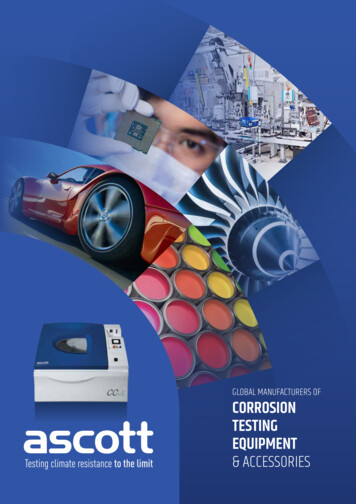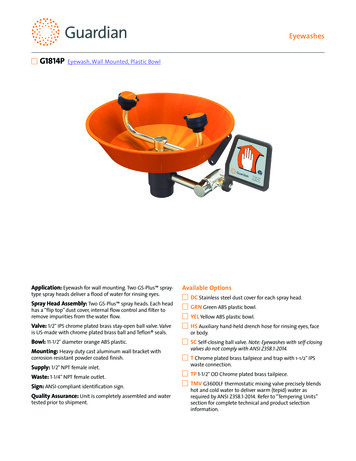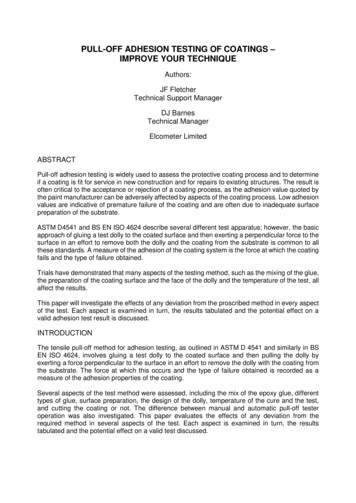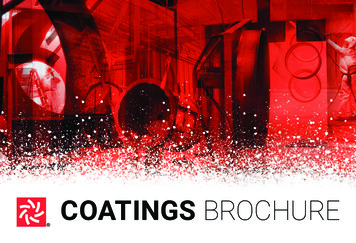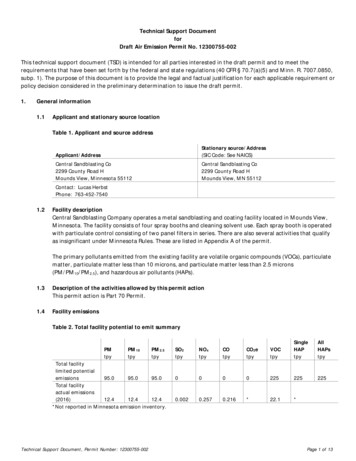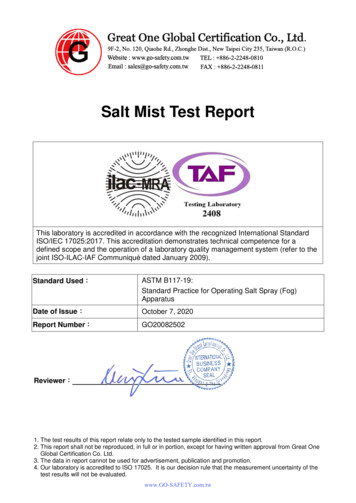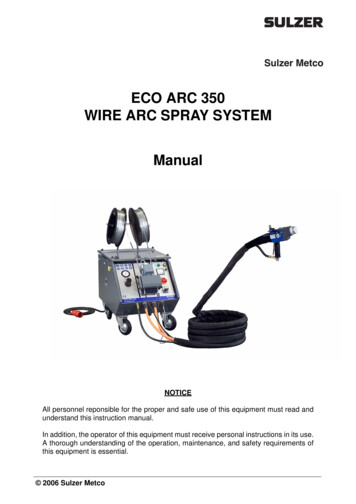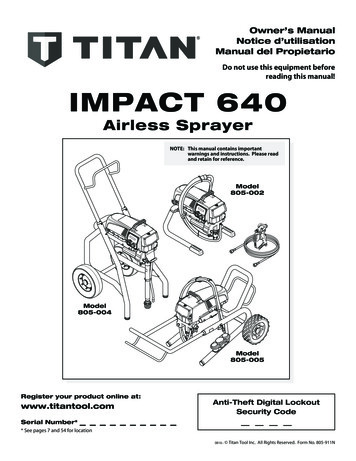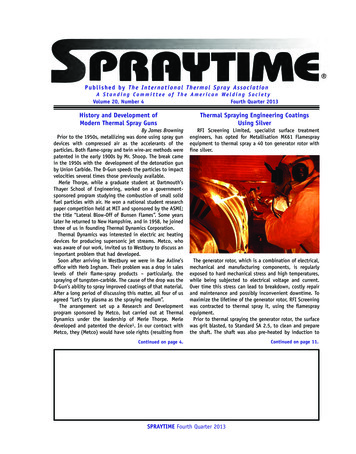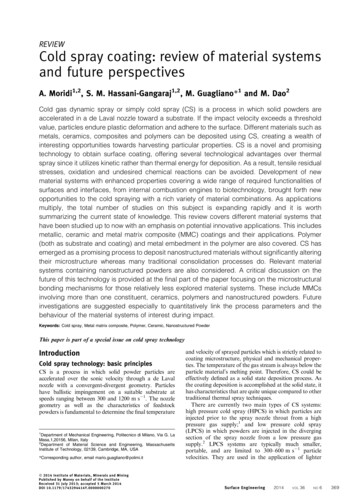
Transcription
REVIEWCold spray coating: review of material systemsand future perspectivesA. Moridi1,2, S. M. Hassani-Gangaraj1,2, M. Guagliano*1 and M. Dao2Cold gas dynamic spray or simply cold spray (CS) is a process in which solid powders areaccelerated in a de Laval nozzle toward a substrate. If the impact velocity exceeds a thresholdvalue, particles endure plastic deformation and adhere to the surface. Different materials such asmetals, ceramics, composites and polymers can be deposited using CS, creating a wealth ofinteresting opportunities towards harvesting particular properties. CS is a novel and promisingtechnology to obtain surface coating, offering several technological advantages over thermalspray since it utilizes kinetic rather than thermal energy for deposition. As a result, tensile residualstresses, oxidation and undesired chemical reactions can be avoided. Development of newmaterial systems with enhanced properties covering a wide range of required functionalities ofsurfaces and interfaces, from internal combustion engines to biotechnology, brought forth newopportunities to the cold spraying with a rich variety of material combinations. As applicationsmultiply, the total number of studies on this subject is expanding rapidly and it is worthsummarizing the current state of knowledge. This review covers different material systems thathave been studied up to now with an emphasis on potential innovative applications. This includesmetallic, ceramic and metal matrix composite (MMC) coatings and their applications. Polymer(both as substrate and coating) and metal embedment in the polymer are also covered. CS hasemerged as a promising process to deposit nanostructured materials without significantly alteringtheir microstructure whereas many traditional consolidation processes do. Relevant materialsystems containing nanostructured powders are also considered. A critical discussion on thefuture of this technology is provided at the final part of the paper focusing on the microstructuralbonding mechanisms for those relatively less explored material systems. These include MMCsinvolving more than one constituent, ceramics, polymers and nanostructured powders. Futureinvestigations are suggested especially to quantitatively link the process parameters and thebehaviour of the material systems of interest during impact.Keywords: Cold spray, Metal matrix composite, Polymer, Ceramic, Nanostructured PowderThis paper is part of a special issue on cold spray technologyIntroductionCold spray technology: basic principlesCS is a process in which solid powder particles areaccelerated over the sonic velocity through a de Lavalnozzle with a convergent-divergent geometry. Particleshave ballistic impingement on a suitable substrate atspeeds ranging between 300 and 1200 m s21. The nozzlegeometry as well as the characteristics of feedstockpowders is fundamental to determine the final temperature1Department of Mechanical Engineering, Politecnico di Milano, Via G. LaMasa,1,20156, Milan, ItalyDepartment of Material Science and Engineering, MassachusettsInstitute of Technology, 02139, Cambridge, MA, USA2*Corresponding author, email mario.guagliano@polimi.itß 2014 Institute of Materials, Minerals and MiningPublished by Maney on behalf of the InstituteReceived 31 July 2013; accepted 5 March 2014DOI 10.1179/1743294414Y.0000000270and velocity of sprayed particles which is strictly related tocoating microstructure, physical and mechanical properties. The temperature of the gas stream is always below theparticle material’s melting point. Therefore, CS could beeffectively defined as a solid state deposition process. Asthe coating deposition is accomplished at the solid state, ithas characteristics that are quite unique compared to othertraditional thermal spray techniques.There are currently two main types of CS systems:high pressure cold spray (HPCS) in which particles areinjected prior to the spray nozzle throat from a highpressure gas supply;1 and low pressure cold spray(LPCS) in which powders are injected in the divergingsection of the spray nozzle from a low pressure gassupply.2 LPCS systems are typically much smaller,portable, and are limited to 300–600 m s21 particlevelocities. They are used in the application of lighterSurface Engineering2014VOL36NO6369
Moridi et al.Cold spray coating: reviewmaterials and they generally utilise readily available airor nitrogen as propellant gases. High pressure systemsinstead, use higher density particles. They utilise higherpressure gases, are stationary and typically generateparticle velocities of 800–1400 m s21. Lower weightgases, such as nitrogen or helium, are the preferredpropellant gases for HPCS.Both aforementioned systems have some limitations.For upstream (high pressure) powder feeding CSsystems, in order to avoid powder back flow, a highpressure powder feeder running at a pressure higherthan that in the main gas stream has to be used. Thehigh pressure powder feeders are usually very big andexpensive. Another major difficulty is related to nozzleclogging. This is more severe when the particle velocityand temperature are increased. To overcome theproblem, a second particle population with either alarger average particle diameter or higher yield strength(hardness/elastic modulus) should be mixed with the firstparticle population.3 Another disadvantage of HPCSsystem is the severe wear of nozzle throat due to particleerosion, which affects the nozzle operation and leads tolarge variations in operating conditions and depositquality. This becomes worse when hard particles arebeing sprayed. On the other hand, the downstream (lowpressure) powder feeding CS systems has simplerequipment. However, the nozzle design in this case isrestricted to relatively low exit Mach number (usually,3). The inlet pressure is also restricted (normally,1 MPa) otherwise the atmospheric pressure will nolonger be able to supply powders into the nozzle. As aresult, only relatively low particle velocities can bereached through the downstream powder feedingtechnique.With the development of the CS process, a number ofstudies were conducted to introduce the technology andits basic principles4–6 and consequently potential applications of CS in different fields were explored.7–10 Morerecently, some variations have been made to the CStechnology. In this part we will also introduce differentvariants of the standard apparatus of CS.The first method is called kinetic metallisation (KM),which is also a solid state process.11 KM is a CS variantthat uses a convergent barrel nozzle under choked flowconditions to achieve an exit gas velocity of Mach 1,with a slight divergence to compensate for frictioneffects. Most other CS systems (including low pressurecold spray) use a de Laval nozzle (convergent–divergentnozzle) to accelerate the process gas to supersonicvelocity.Another variation to CS set up is called pulsed gasdynamic spraying (PGDS).12 This process heats up theparticles to an intermediate temperature (still belowmelting temperature) which is expected to be higher thantemperatures experienced in the CS process. Increasingthe temperature will result in a decrease of the criticalvelocity which is of technological value. In addition, itleads to a higher level of plastic deformation whilemaintaining the same impact velocity. This process hasalso a discontinuous nature which exploits non-stationary pressure waves to generate simultaneously higherpressure and temperature than in CS process (where acontinuous, stationary flow exists.).Another variation to CS is called vacuum cold spray(VCS). In this process the specimen is placed in a370Surface Engineering2014VOL36NO6vacuum tank with a pressure that is substantially less thanthe atmospheric pressure. The low pressure environmentis provided by a vacuum tank coupled to a vacuum pump.The vacuum tank allows for gas recovery and for powderoverspray collection.13 It is worth noting that a similardesign has been also disclosed which is called aerosoldeposition method (ADM). In this process, nanoparticlesare sprayed in a vacuum chamber using a propellant gasflow of helium or air. In this method, the propellant gaspressure is also below atmospheric pressure and thevelocity reached is lower than that for CS. This processreduces the presence of the shockwave at the substrate orbow shock effect significantly, making it possible todeposit very small particles.14 A schematic of different CSsystems is shown in Fig. 1.The main and more applicable categories of CStechnology have been described. Nevertheless introducing all the patented CS apparatus is out of the scope ofthe present review and interested readers are referred tothe available review on this topic.15Impact phenomena and bonding mechanismsParticles/substrate interaction during the CS depositionprocess and the resultant bonding, is of great importance in CS technology because of the effect on coatingcharacteristics. Experimental studies and computationalmodelings have been performed to have a betterunderstanding of the bonding process during CS.16They revealed that adhesion only occurs when thepowder particles exceed a critical impact velocity whichis specific to the spray material.17 The predominantbonding mechanism in CS is attributed to ‘adiabaticshear instability’ that occurs at the particle substrateinterface at or beyond the critical velocity. A strongpressure field is introduced as a result of particle impacton the substrate. Consequently, a shear load is generatedwhich accelerates the material laterally. This causeslocalized shear straining which under critical conditionsleads to adiabatic shear instability.18–20The initiation of adiabatic shear instability is usuallydescribed by thermal softening in competition with rateeffects and work hardening. During work hardening, thedistortion of grain structure and the generation andglide of dislocations occur. The rest of the plastic work,which can be as much as 90% of the total, is dissipatedas heat. Heat generated by plastic work softens thematerial. At a certain point, thermal softening dominates over work hardening such that eventually stressfalls with increasing strain. As a result, the materialbecomes locally unstable and additional imposed straintends to accumulate in a narrow band.21 Consequently,an interfacial jet composed of the highly deformedmaterial is formed. Experimental results show that theminimal particles impact velocity needed to produceshear localisation at the particles/substrate interfacecorrelates quite well with the critical velocity for particledeposition by the CS process in a number of metallicmaterials. So far adiabatic shear instability is the mostprevailing bonding theory in CS.20 By explaining thebonding mechanisms one can see that both mechanicaland thermal properties of the powder material areimportant in particle-substrate bonding.The success of the CS process depends mainly on thecorrect choice of the process velocity which should be setto lie between the critical and erosion velocity. Erosionvelocity is an upper limit for particle velocity beyond
Moridi et al.which erosion occurs instead of adhesion. Assadi et al.19used finite element simulation to study the effect ofvarious material properties on the critical velocity in CS.They also presented a simple formulation for the criticalvelocity estimation which expresses it as a function ofimpact temperature, particle density, melting temperatureand ultimate tensile strength. The formulation was latermodified by addition of the particle diameter effect bySchmidt et al.22 They argued that the size effect in impactdynamics can have a significant influence on the criticalvelocity. The results obtained from copper and stainlesssteel 316L clearly demonstrated that the critical velocitydecreases with increasing particle size. This can beattributed to the effects of heat conduction or strain ratehardening. Another finite element model was developedlater based on the determination of the adiabatic shearinstability, which resulted in the predicted critical velocityassessment close to the experimentally extracted values.23An important parameter which was not considered inprevious models but has a significant effect on the criticalvelocity is particle porosity. As the oxygen content offeedstock increases, the critical velocity significantlyincreases.24–27 An oxide accumulated at the particle/substrate interface obstructs the adhesion betweenactivated particle and substrate surface during impact.A hybrid approach containing finite element model andanalytical solution was developed by Moridi et al.28 topredict both critical and erosion velocities. Based on theresults, the existing formulation was further developedtaking into account the effect of particle porosity incalculation of critical and erosion velocities.Conventional versus new material systemsThe worldwide materials industry has experienced arevolution related to new materials and their commercialproduct applications. Advanced materials can be used ascoatings to reduce material consumption. Following that,CS technology with its unique properties is a primecandidate. In the last decade, there has been a continuoustrend toward spraying new materials for specific applications. At the beginning, CS technology was mostlyconducted on selected metallic materials to understandthe adhesion mechanism involved during the process.Soon it spread to other materials and currently a widevariety of materials has been successfully deposited toobtain surfaces with superior and possibly multifunctional properties. For instance one could mentionsuccessful deposition of brittle compounds in a ductilematrix and its commercial applications. The technologyhas emerged into polymers as well, but the area is stilldeveloping and there is a lot more to explore. Currently,studies in this field are expanding and the main purpose ofthis review is to summarize the current state of knowledgeon various material systems, focusing on the mostpromising material systems under development. In thisperspective, material systems involved in CS technologyare divided into six important categories: metals, metalmatrix composites, ceramics, polymers, nanostructuredpowders and finally nonmetallic substrates.Material systemsMetalsDifferent material systems that have already been coldsprayed will be discussed. We will start with the materialeligibility for CS process is first described. AlthoughCold spray coating: reviewexceeding the critical velocity is necessary for successfulbonding and coating formation, one can also ratematerial suitability for CS process. The suitability ofmaterials depends mainly on their deformation properties. Different crystal structures have different dislocationsystems. A systematic approach has been developed todetermine the eligibility of materials considering the basicphysical properties such as material hardness, meltingtemperature, density and particle velocity.29 Materialswith relatively low melting point and low mechanicalstrength such as Zn, Al, and Cu are ideal materials, asthey have a low yield strength and exhibit significantsoftening at elevated temperatures. No gas pre-warmingor only low process temperatures are required to producedense coatings using these materials. It is worthmentioning that the deposition of Al is somewhat moredifficult than other soft materials such as Zn and Cu. Thisis attributed to its high heat capacity which makes it moredifficult to achieve shear instability conditions duringimpact, in spite of its low melting point and low yieldstrength. This classification is based on physical properties. Thermal properties of material are not taken intoaccount although they can be important factors as well.There are quite a number of studies available in theliterature on depositing Cu and its alloys,30–38 Al and itsalloys30,39–44 and Zn and its alloys.45–47In contrast, for the majority of materials with higherstrength such as Fe and Ni base materials, the lowprocess temperatures generally do not provide enoughenergy for successful deposition. Although these materials are in general not ideal for CS deposition, this neverinhibited the spreading of CS technology to deposit suchmaterials. Several reports are available on deposition oftitanium and its alloys,48–53 stainless steel,46 nickel andits alloys,54–56 and tantalum.57–60The available literature in this section mostly discussedthe deposition of metal and metal alloy particles and theirresulting microstructures. The effect of CS coating ondifferent mechanical characteristics such as fatigue, corrosion, bond strength, hardness, oxidation, etc. has beeninvestigated. These properties are all of industrial interests.Among these, fatigue accounts for about 90% of allmechanical failures. However, less attention has been paidto the fatigue performance of cold spray coating. Theavailable literature on this topic presents controversialresults. Some material systems showed improvement whilethe others showed deterioration of fatigue limit. The resultscould be interpreted as follows: if the coating remainsattached to the substrate during the fatigue test; it canpotentially increase the fatigue limit. Considering availabledata one might speculate that the level of improvement offatigue limit depends on the amount of compressiveresidual stress in the coating and substrate and moreimportantly on the difference between the coating fatiguelimit and the substrate fatigue limit. The coating shouldhave higher fatigue limit to be able to increase the coating/substrate system fatigue limit. The higher the difference,the higher the coating/substrate fatigue limit will be, in thecase that coating remain attached. The influential parameters are gathered in a formula, which can predict thefatigue limit of CS system as a function of residual stress,coating hardness and stress gradient in the specimen.61Besides, there were also some studies concerningmicrostructure evolution such as the effect of postannealing treatment on forming a diffusion bond andSurface Engineering2014VOL36NO6371
Moridi et al.Cold spray coating: review1 Schematic of different CS systems: a low pressure cold spray; b high pressure cold spray; c vacuum cold spray;13d kinetic metallisation;11 e pulsed gas dynamic spraymaking intermetallic compounds,30,41 effect of vacuumheat treatment on the microstructure and microhardness,36 phase stability,62 and effect of quasi crystallineparticles of submicrometre and nanoscales (,100 to200 nm) on the deformation-induced structure.63There were also quite a number of studies on coldspraying of thermal barrier coatings (TBC) which insome cases did not show significant improvement infunctionality over high velocity oxy-fuel (HVOF)deposition method.64,65 Increasing demands for highergas turbine engine performance have led to the development of TBC systems applied to the engine’s hotcomponents. TBCs typically consist of an underlyingMCrAlY bond coat with an yttria partially stabilisedzirconia (YSZ) ceramic top coat.66 The latter acts as athermal insulator whereas the former promotes bondingbetween the part and the top coat and providesprotection against oxidation and hot corrosion. Incontrast to the generally accepted theory that the CSprocess does not lead to changes in the deposited372Surface Engineering2014VOL36NO6material’s microstructure and phase, results ofCoNiCrAlY coatings deposited using the CS systemdemonstrated the occurrence of notable microstructuraland phase changes.67 There are also some studies onnanostructured MCrAlY coatings as well, which will bediscussed later in the section devoted to ‘Nanostructuredpowders’.Cross-sections of selected metallic cold spray coatingsare illustrated in Fig. 2. The coating microstructurevaries in different cases but, generally, dense coatingswith small porosities are obtained by CS process.Amorphous metals have also been deposited usingCS. An amorphous metal (also known as metallic glassor glassy metal) is a solid metallic material, usuallycharacterised by its lack of crystallographic defects suchas grain boundaries and dislocations typically found incrystalline material.68,69 The absence of grain boundaries, the weak spots of crystalline materials, leads tobetter resistance to wear and corrosion in amorphousmetals. Therefore, they are potential candidates to form
Moridi et al.Cold spray coating: review2 Cross-section of selected metallic CS structures: a Al 6082 on Al 6082;44 b Ti on Ti6Al4V;52 c Inconel 718 on Alalloy;54 d Ta on Al;57 e Ni on Al alloy55a strong coating. Amorphous metals, while technicallyglasses, are also tougher and less brittle than oxideglasses and ceramics. In fact, they exhibit uniquesoftening behaviour above their glass transition temperatures. There are several ways in which amorphousmetals can be produced, including extremely rapidcooling, physical vapour deposition, solid state reaction,ion irradiation and mechanical alloying. More recently anumber of alloys with low critical cooling rates havebeen produced; these are known as bulk metallic glasses(BMGs).70,71 Perhaps the most useful property of bulkamorphous alloys is that they are true glasses, whichmeans that they soften and flow upon heating.Bulk metallic glasses display superplasticity within asupercooled liquid region (Tg to Tx; Tg is glass transitiontemperature where significant softening occurs and Txis ductile–brittle transition temperature). However, thedegradation of the properties of amorphous BMGs canoccur due to crystallisation driven by external energyinput through heating and mechanical deformation.72,73Also, it has been confirmed that thermal energy releasedthrough mechanical deformation can result in thenanocrystallisation of BMGs. There are a few recordsavailable in the literature on CS deposition of metallicglasses.74,75 According to calculations and CS experiments, neither the glass transition temperature Tg nor themelting temperature Tm can adequately describe therequired conditions for bonding. Thus, the so calledsoftening temperature between the glass transition temperature and the melting temperature had to be defined todetermine the critical velocity of metallic glasses.The impact of BMG particles with different initialtemperatures is shown in Fig. 3. The different deformability in super liquid region without any cracking canbe easily seen in the figure.Critical discussionThe literature on deposition of metallic materials via CSis rich. Metallic powders were the first class of materialsbeing investigated for CS process. Since the invention ofCS, there has been a number of fundamental studies inthe field of gas dynamics of CS, the interaction of a highspeed particle with the substrate and the related bondingmechanism. However, there are still some open questions such as the material behaviour under extremedeformation conditions including very high strain ratesof up to 109 s21. In addition, less attention has been paidto the coating build up (particle to particle impact)mechanism and studies were more focused on theinitiation phase of the coating formation (particle tosubstrate).Another possible avenue to explore is finding themajor parameters that may play a role in the adhesionduring CS deposition of BMGs. Another missing chainin the field of CS is that there is not a standard way toquantitatively characterise CS coatings for comparingresults of different deposited coatings. The progress inthis aspect will be very helpful to reveal the strengthsand weaknesses of different CS apparatus and CSconditions in comparison to each other. Some researchers suggest free standing coatings can be used to test thecoating properties and compare coatings obtained bydifferent technologies and parameters. Nonethelessthere is an argument that it is crucial to capture theinteraction of substrate and coating during experimentalprocedures.Metal matrix compositesThe limitation of material applicable as feedstock for CScomes from its bonding nature. Feedstock powders musthave some degree of ductility at high strain rate in orderSurface Engineering2014VOL36NO6373
Moridi et al.Cold spray coating: review3 BMG impact particles with different initial temperatures: a room temperature; b between Tg and Tx; c above Tx(Ref. 75)to form shear deformation on the contacting surfaces andconsequently result in bonding and coating build up.Therefore, CS seems not to be so convenient forproducing coatings made from brittle materials. On theother hand, by increasing demand for coating tribologicalproperties, hard particles with enhanced hardness areneeded. Because of their lack of ductility they cannot bedeposited directly. In addition, intermetallic compounds(involving two or more metallic elements, with optionallyone or more non-metallic elements in solid phase, whosecrystal structure is different from the other constituents)are also generally brittle and have a high melting pointwhich is not appropriate for CS. To solve the problem,addition of hard particles to deformable metallic matrixappeared to be an appropriate solution.76The idea of metal matrix composite (MMC) wasimplemented to facilitate deposition of brittle materials.MMC is a composite material with at least twoconstituent parts, one being a metal and the other beinga different metal or other material. MMC manufacturing techniques can be divided into three types: solidstate, liquid state, and vapour deposition. In recentyears, CS has emerged among solid manufacturingprocesses of MMC. Blending different powders andcold spraying them on the substrate is the widely appliedmethod. Because of the low deposition temperatureduring CS, there are no significant reactions during thespraying of mixed powders. There are other advantagessuch as lower oxygen content and higher density for theobtained coating. These advantages help to reduceshrinkage during any subsequent heat treatment.In case of two metals forming a MMC, a postdeposition heat treatment can result in the formation ofintermetallic compounds in a controlled environment. Incase of a combination of metal with hard particles, metalacts as matrix allowing hard particles to be embeddedand facilitating the development of high density orfunctional coatings.77MMC, depending on the involved materials, hasdifferent applications which are summarised in thissection. This section is divided into two categories. Inthe first group, the main components are metals and inthe second group, metal and hard particles are depositedtogether. There is not an established criterion to ensurethe success of CS process during deposition of compositematerials. All numerical studies in the literature havefocused on metal powder deposition and the criticalvelocity as a criterion for bonding. Since there are nocriteria for successful deposition of composite powders,different studies in this field have used experimentaltools such as optical, transmission and scanning electron374Surface Engineering2014VOL36NO6microscopy (SEM), as well as micro hardness and bondstrength tests to evaluate the coatings characteristics.Metal-metal matrix compositeIn this section we will review the available literature onthe deposition of combination of pure metals, metalalloys and intermetallic compounds. Note that intermetallic compounds are different from alloys althoughthey are both metallic phases having more than oneelement. In intermetallic compounds, different elementsare ordered into different sites with different environment while in alloys, they substitute randomly in thecrystal structure.A reasonably dense material was produced by HPCSof Ti/Al.77 A mixture of Al and Ti regions was found inthe coating. The temperature during process was lowenough preventing particles from being alloyed together.It was shown that post heat treatment can convert Ti/Aldeposits into intermetallic materials. Subsequent postspray heat treatment at 630uC for 5 h was performed onco-deposited Ti/Al to prepare a novel TiAl3–Al coating.78 In the coating structure TiAl3 phase embedded inthe residual aluminium matrix. An interlayer about10 mm was formed between the coating and thesubstrate. High temperature oxidation protection wasproved for the base orthorhombic Ti–22Al–26Nb (at-%)alloy with no sign of degradation after being subjectedto 150 oxidation cycles at 950uC. The microstructureanalysis of the oxidised composite coating showed thatan Al2O3 scale with a complex structure can be formedoutside the interlayer during oxidation. No oxidebeneath the interlayer was detected, which indicatesthat the complex continuous Al2O3 and the interlayerprovided the protection of the substrate under the hightemperature oxidation condition.The most influential factor in compounding reactionis solid state diffusion. The defect generation during theCS process can have an effect on diffusion. Theprocessing parameters, such as gas pressure, gastemperature, and powder feeding rate, etc., couldinfluence the particle velocity and subsequently thecoating properties such as coating density and defectdensity. The relationship between gas pressure and Albased intermetallic compound formation was investigated.79 Spraying Al onto Ni substrate and AlzNi ontoAl substrate was investigated. Post annealing wasperformed on different samples at low temperatureand intermetallic compound layers of Al3Ni and Al3Ni2were observed. The relatively soft Al has been coatedunder a low gas pressure condition (0?7 MPa) withsevere plastic deformation owing to large peening effect.
Moridi et al.Cold spray coating: review4 a W/Cu composite powder and b cross-section of resulting CS coating82On the contrary, the Al particles coated at higherpressures (1?5 and 2?5 MPa) were not severelydeformed. The pressure controlled peening effects couldalter the main route of Al consumption during annealing: eutectic or compounding of intermetallics. The thinand continuous intermetallic compound layer wasformed at the interface with
REVIEW Cold spray coating: review of material systems and future perspectives A. Moridi1,2, S. M. Hassani-Gangaraj1,2, M. Guagliano*1 and M. Dao2 Cold gas dynamic spray or simply cold spray (CS) is a process in which solid powders are accelerated in a de Laval nozzle towar
